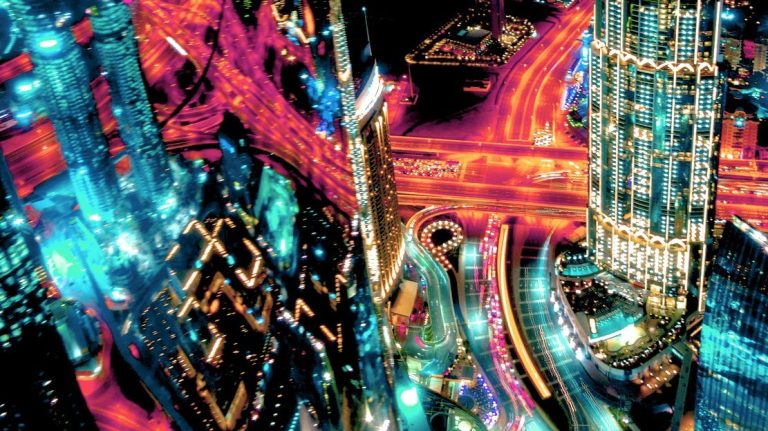Top Tips When Flying Drones at Night

When dusk has fallen, Sky Vision’s drone pilots (in the UAE) are afforded some exquisite opportunities to take to the skies and capture panoramic images of one of the most contrasting skylines in the world. Chic, colour-rich urbane environments are juxtaposed with sublime, muted desert landscapes, presenting unique opportunities to capture inspirational images.
However, as experienced as a daytime drone pilot may be, flying drones at night presents a different proposition altogether. Standard daytime flight dexterity and practices must be honed to account for reduced vision. The more experienced drone shooting services in Dubai are, the more proficient they’re likely to be when flying drones at night.
Experience and proficiency aside, what do you need to know when flying drones at night in Dubai? Here’s a handful of necessities to consider when planning a twilight drone flight.
Know the Area
When flying drones at night, it’s paramount that you know the area. Whether the location is one that you frequent often or if you’ve undertaken numerous scouting excursions prior to your first flight, you need to make sure that you know where your flying like the back of your hand.
Why? It’s obvious – reduced visibility. Make sure to note where buildings, natural landmarks, power lines, or any other obstacles are. The first night time drone flight can be a mite jarring, even for experienced pilots. The more the know, the more likely you are to mitigate any potential hazards.
Be Aware of Your Surroundings
Not altogether dissimilar from knowing the area of your nocturnal flight is the awareness you have of your surroundings. Drone video services in Dubai – and experienced hobbyists – are well-versed with using their phone or other portable control system to fly their drone. However, this does preclude pilots from persistently fixing their eyes on their drone when in flight.
Why is this a problem if you have a screen display? Well, when your drone is airborne in the reduced visibility of dusk, keeping an eye on the flight path at the expense of obstacles can distract pilots from the immediate surroundings. Remember it only takes a small collision for your drone to incur damage – and, in the worst-case scenario, plummet to the ground.
The ND Filter
For anyone unaware, a ND filter (or neutral density filter) allows a photographer to control the image exposure by reducing the amount of light entering a camera’s lens. Under bright sunlight, a ND filter gives photographers more options when selecting an aperture and shutter speed, thereby preventing overexposure.
Long exposure shots should be straightforward for experienced drone shooting services in Dubai to capture as the cameras on DJI drones are stabilized. In setting the right shutter speed, photographers can capture light trails which contrast the murky night sky with piercing landmark illumination, for example.
Capturing vivid colours with your daytime drone photography requires an ND filter. Using the smallest aperture and the lowest ISO possible will inevitably overexpose your shot. Therefore ND filters should be applied. However, with the reduced dusk lighting, this is simply not the case. Shooting at night using an ND filter will result in dull colours and muted, uninspiring images.
Fly at an Increased Altitude
When flying from point A to point B at night, it’s advised that pilots increase their altitude. Why? To avoid any obstacles. The higher you can reach in the sky, the less likely you are to collide with power lines or architectural aspects of a building.
It’s always advised to be safe, rather than sorry, and this ethos is no more apparent whether you employ drone video services in Dubai or if flying your drone personally. Reduced visibility can obscure all manner of hazards and be especially challenging for anyone remotely-controlling their drone from the ground.
The bottom line is that even if you’ve conducted comprehensive research of the location and know precisely every dot on the landscape, you’ll need to exercise caution to ensure that collisions are 100% mitigated. It’s almost impossible to know the minutest details of your flight path ahead of time. The best way to do this is to soar at an altitude and take a flight path that offers zero opportunity for collision – in other words fly as far away from any potential collisions.
Reduce the Brightness of Your LED Lights
Intending to capture some jaw-dropping aerial photography shots of Dubai? Don’t forget to turn the LED’s on your drone off. LED’s may be great for identifying your drone, but the illumination of the lights that cause a red glare that will penetrate all your images.
If you can vastly reduce the brightness of the LEDs and still be able to identify your drone in the night’s sky, this may be the best solution. The problem with turning your LED’s off altogether is that should you lose control of your drone, or veer away from a flight path, it will be very difficult to find your drone should you land in a spot that you didn’t intend to.
The good news is that experienced drone shooting services in Dubai and hobbyist pilots know to control the brightness of their LED lights. But for anyone unaware, all you need to do is to go into camera settings and general, then select LEDs Auto Turn Off. This automatically turns off LEDs when you start recording or press the shutter button to capture an image. Learning to control the LED light function yourself is integral to capturing those dazzling night-time images.
These are five tips to successfully operating drones and camera equipment at night. Learn each and you’ll feel confident controlling your drone at night and be able to capture photos and videos that will truly inspire.